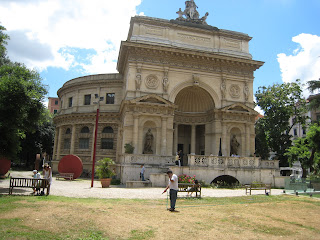6.
Albergo Mediterraneo. Exiting the train station, bear left and enter via Cavour, at a right angle to the station. One block down, on the right at via G. Amendola is the hotel, Albergo Mediterraneo, built in the 1930s. Stolid on the outside (though not without interest; the travertine marble is standard-issue for many buildings of the period, and even the revolving door, with its worn brass fittings, is suggestive), exquisite on the inside.

Your goal here is to nose around the lobby and adjoining rooms while looking more or less as if you belong. On our visit, the desk clerks seemed not to care about our presence, but we would recommend some attire besides shorts and tennis shoes. Among the items of interest: several ornate, inlaid wood wall sculptures and, in the sitting room to the left, a wall-size map of—you guessed it—the Mediterranean. All vintage. The roof boasts a modest but pleasant bar/restaurant, open to the public (take the elevator opposite the main desk).
7.
Rambo World. From the hotel entrance, cross via Cavour and continue ahead on via G. Amendola. A couple blocks on the right, at #91/93, is Paolo Belletatti: Articoli Civili e Militari (civilian and military items), which at first struck us as the kind of right-wing place that Bruce Willis fell into in Quentin Tarantino’s 1994 classic,
Pulp Fiction, with a torture chamber in the basement for anyone who doesn’t want to return to Vietnam with a bowie knife between his teeth.

To be sure, there are plenty of T-shirts with distasteful slogans (most in Italian) and metal castings of the Fascist fasci for the desktop of your favorite corporate bully. But the atmosphere is low key, there are lots of “civilian” items that would make funky gifts for that special someone (including teddy bears in military dress), and the owner—Paolo, we presume—is a peach, to the point of running a block to return our glasses case, which we (Bill) had left on the counter. Not open about 1-4, Saturday afternoons nor all day Sunday.
8.
Casa dell’Architettura. Continuing down via G. Amendola, 3 blocks from via Cavour (and between via C. Cattaneo and via Ratazzi), is a lovely space of urban respite—a small park, lodged in Piazza Manfredo Fanti, with benches, the ruins of a Roman house, works of art and, incredibly, grass that gets watered and cut—and within the grounds, the 19th-century gem that houses the Casa dell’Architettura (House of Architecture), a bookstore that specializes in architecture, and a café whose tables spill out into the gardens.

As we wrote in
Rome the Second Time, the Casa “inhabits an unusual 19th-century building restored to its late baroque beauty, the Aquario Romano (built to house an aquarium and fish hatchery).” It’s worth going inside and having a look (no charge); there are often exhibits.
9.
Wholesale Shopping, Ethnic Style. Exit the gate at Casa dell’Architettura and turn right (yes, we’re just a trifle beyond our promised maximum of 200 yards from the front of the train station), continuing down what is now called via Filippo Turati. In the next few blocks and on adjoining streets, you’ll pass dozens of small shops selling clothes, shoes, and jewelry.

Most of the employees and owners are Chinese, though some of the stores—it depends on the street—are tended by those of mid-Eastern or south Asian descent. In the early afternoon, family, clerks, and children gather around the small display tables that center many of the stores and share lunch.
As we’ve noticed before, the shops seem to have merchandise but few customers; our theory is that they’re basically wholesale outlets, serving the area’s itinerant merchants and other establishments. Although the clerks often speak little English (and perhaps not much Italian, either), the stores are open to walk-in retail trade; we bought some inexpensive bracelets in one. As we recall, the only words that were spoken to us were the total price, in dollars. Our Italian friends claim that profits from these small businesses is essentially beside the point; big, unsavory Chinese money has selected the area for takeover—apartments, commercial establishments, everything--and the function of many of the businesses is to launder money involved in that process.
Whatever the truth of those claims, the volume of merchandise is substantial. We recommend a visit to the area’s “mall,” a square block of shops (surrounding a comfortable courtyard with benches and, when we visited, a photo exhibit). It’s located a couple of blocks down from the Casa dell’Architettura (above), just past via Mamiani.
10.
Church of Santa Bibiana. This gem of a church is as far as you’ll ever want to go on via Giolitti – the street that runs along the south side of the station. It sits improbably next to the station’s outer buildings (look for the adjoining tall round tower, covered in travertine with spiral staircase – a fine example of modernism), and is now dangerous to approach across intra-city train tracks and the entrance to the underground passageway that leads to the other side of the major tracks.

The extant church of 1624-26 (the first one on the site dates to the 5th century) is by Bernini, his first major commission. He already was in fine form, as shown in his portico, façade and sculpture of the saint. Dianne will elaborate on this church in a separate post on some hidden churches of Rome. You may want to pray to the saint if you make it safely to her church and also hit the unusual opening hours: 7:30 - 10 a.m. and 4:30-7:30 p.m. You can’t enter as a gawker during masses (weekdays 8 a.m. and 6:30 p.m. and Sundays 8:30, 10, 11:30 in the morning and 6:30 p.m.).
Bill, with Dianne as church lady on #10



